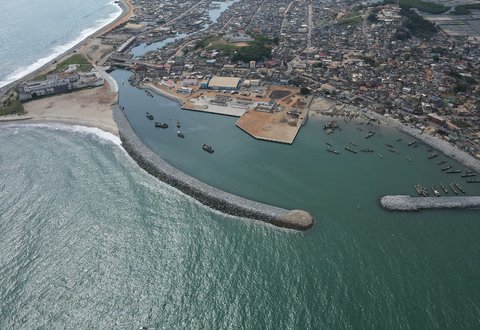
Coasts & Estuaries
The world's coastlines are being affected by climate change, resulting in rising sea levels, stronger storms, and higher temperatures. These changes are causing coastal flooding and erosion of shorelines, making coastal and estuarine areas more susceptible to the impacts of climate change. Given the significant economic value of coastlines to many nations, safeguarding them from the effects of climate change is becoming increasingly crucial. Our challenge, at IMDC, is to understand the dynamics and interactions between the natural and anthropogenic processes and to aspire to sustainable coastal and estuarine management.

In order to gain insights into the effects of climate change and determine the most effective approach for addressing them, our experts employ a range of numerical models, empirical techniques, and physical model experiments to examine and investigate the hydrological and morphological dynamics along coastlines. We focus on processes like coastal erosion, sedimentation, wave behavior, overtopping, flooding, and sediment movement in both cross-shore and longshore directions. The figure on the right shows an example of cross-shore sediment transport caused by wave action in Elmina, Ghana.
Through the utilization of these models and methodologies, the Coasts & Estuaries team possesses the ability to provide the following services:
- Hazards and Risk Management
- Coastal Zone Management
- Estuarine Management
- Climate Change Adaptation and Integrated Management
 1. Hazards and Risk Management
1. Hazards and Risk ManagementWith the increasing frequency and intensity of hydrometeorological hazards, our service offers proactive measures to assess vulnerabilities and develop effective disaster management strategies. We use advanced engineering techniques, cutting-edge modeling tools, and data-driven analysis, to identify potential risks and provide valuable insights into the impacts of events such as floods, storms, and droughts. Hydrometeorological hazards and disaster management involve understanding and mitigating the risks and impacts of natural hazards related to weather and water. It involves a range of activities, including risk assessment, early warning systems, emergency response planning, evacuation procedures, infrastructure resilience, and community preparedness.
References: MOSCI;

1. Hazards and Risk Management
With the increasing frequency and intensity of hydrometeorological hazards, our service offers proactive measures to assess vulnerabilities and develop effective disaster management strategies. We use advanced engineering techniques, cutting-edge modeling tools, and data-driven analysis, to identify potential risks and provide valuable insights into the impacts of events such as floods, storms, and droughts. Hydrometeorological hazards and disaster management involve understanding and mitigating the risks and impacts of natural hazards related to weather and water. It involves a range of activities, including risk assessment, early warning systems, emergency response planning, evacuation procedures, infrastructure resilience, and community preparedness.
References: MOSCI;

2. Coastal Zone Management
Coastal engineering and management involves planning, designing, and maintaining coastal areas to ensure their sustainable development. It includes coastal protection through defense structures, managing beaches and shorelines, harbor and port development, erosion control, flood and storm surge management, coastal zone planning, environmental impact assessment, and promoting sustainable coastal development. The field aims to balance human needs, environmental protection, and the utilization of coastal resources, safeguarding coastal communities and ecosystems from erosion, sea-level rise, and climate change.
References: Elmina; Blankenberge-Wenduine; Ada;
3. Estuarine Management
Within Estuarine Engineering and Management, we focus on the planning, design, and maintenance of estuaries to ensure their sustainable development and the preservation of their valuable ecosystems. It encompasses various aspects such as estuarine protection, shoreline management, harbor and port development, erosion control, flood and storm surge management, estuarine zone planning, environmental impact assessment, and promoting sustainable estuarine development. The field aims to strike a balance between human needs, environmental protection, and the responsible utilization of estuarine resources. By implementing strategies that address erosion, sea-level rise, and climate change impacts, estuarine engineering and management.
References: Westerschelde;
4. Climate Change Adaptation and Integrated Management
Our expert engineers provide innovative and tailored solutions to address the unprecedented challenges posed by climate change. With our integrated approach, we help you navigate the complex landscape of climate change impacts and develop proactive strategies for adaptation. By combining cutting-edge engineering principles with holistic management approaches, we ensure sustainable development and resilience for your projects. Our expertise in climate change adaptation allows us to assess the vulnerability of your systems and identify risks from hydrometeorological hazards. Our commitment to incorporating Nature Based Solutions (NBS) sets us apart as we work harmoniously with nature to enhance ecosystem services.
References: Kustvisie;


